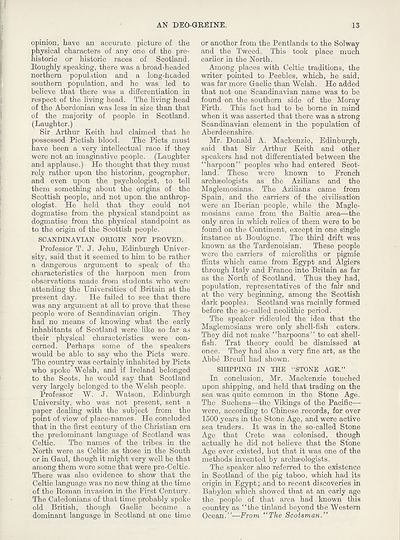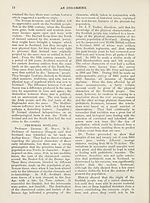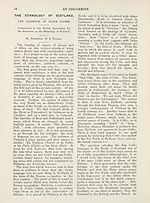An Comunn Gàidhealach Publications > Deo-gréine > Volume 17, October 1921 to September 1922
(21) Page 13
Download files
Complete book:
Individual page:
Thumbnail gallery: Grid view | List view

AN DEO-GREINE.
13
opinion, have an accurate picture of the
physical characters of any one of the pre¬
historic or historic races of Scotland.
Koughly speaking, there was a broad-headed
northern population and a long-headed
southern population, and he was led to
believe that there was a differentiation in
respect of the living head. The living head
of the Aberdonian was less in size than that
of the majority of people in Scotland.
(Laughter.)
Sir Arthur Keith had claimed that he
possessed Pictish blood. The Piets must
have been a very intellectual race if they
were not an imaginative people. (Laughter
and applause.) He thought that they must
rely rather upon the historian, geographer,
and even upon the psychologist, to tell
them something about the origins of the
Scottish people, and not upon the anthrop¬
ologist. He held that they could not
dogmatise from the physical standpoint as
dogmatise from the physical standpoint as
to the origin of the Scottish people.
SCANDINAVIAN ORIGIN NOT PROVED.
Professor T. J. Jehu, Edinburgh Univer¬
sity, said that it seemed to him to be rather
a dangerous argument to speak of the
characteristics of the harpoon men from
observations made from students who were
attending the Universities of Britain at the
present day. He failed to see that there
was any argument at all to prove that these
people were of Scandinavian origin. They
had no means of knowing what the early
inhabitants of Scotland were like so far as
their physical characteristics were con¬
cerned. Perhaps some of the speakers
would be able to say who the Piets were.
The country was certainly inhabited by Piets
who spoke Welsh, and if Ireland belonged
to the Scots, he would say that Scotland
very largely belonged to the Welsh people.
Professor W. J. Watson, Edinburgh
University, who was not present, sent a
paper dealing with the subject from the
point of view of place-names. He concluded
that in the first century of the Christian era
the predominant language of Scotland was
Celtic. The names of the tribes in the
North were as Celtic as those in the South
or in Gaul, though it might very well be that
among them were some that were pre-Celtic.
There was also evidence to show that the
Celtic language was no new thing at the time
of the Roman invasion in the First Century.
The Caledonians of that time probably spoke
old British, though Gaelic became a
dominant language in Scotland at one time
or another from the Pentlands to the Solway
and the Tweed. This took place much
earlier in the North.
Among places with Celtic traditions, the
writer pointed to Peebles, which, he said,
was far more Gaelic than Welsh. He added
that not one Scandinavian name was to be
found on the southern side of the Moray
Firth. This fact had to be borne in mind
when it was asserted that there was a strong
Scandinavian element in the population of
Aberdeenshire.
Mr. Donald A. Mackenzie, Edinburgh,
said that Sir Arthur Keith and other
speakers had not differentiated between the
“harpoon” peoples who had entered Scot¬
land. These were known to French
archaeologists as the Azilians and the
Maglemosians. The Azilians came from
Spain, and the carriers of the civilisation
were an Iberian people, while the Magle¬
mosians came from the Baltic area—the
only area in which relics of them were to be
found on the Continent, except in one single
instance at Boulogne. The third drift was
known as the Tardenoisian. These people
were the carriers of microliths or pigmie
flints which came from Egypt and Algiers
through Italy and France into Britain as far
as the North of Scotland. Thus they had,
population, representatives of the fair and
at the very beginning, among the Scottish
dark peoples. Scotland was racially formed
before the so-called neolithic period.
The speaker ridiculed the idea that the
Maglemosians were only shell-fish eaters.
They did not make “harpoons” to eat shell¬
fish. Trat theory could be dismissed at
once. They had also a very fine art, as the
Abbe Breuil had shown.
SHIPPING IN THE “STONE AGE.”
In conclusion, Mr. Mackenzie touched
upon shipping, and held that trading on the
sea was quite common in the Stone Age.
The Suchens—the Vikings of the Pacific—
were, according to Chinese records, for over
1500 years in the Stone Age, and were active
sea traders. It was in the so-called Stone
Age that Crete was colonised, though
actually he did not believe that the Stone
Age ever existed, but that it was one of the
methods invented by archaeologists.
The speaker also referred to the existence
in Scotland of the pig taboo, which had its
origin in Egypt; and to recent discoveries in
Babylon which showed that at an early age
the people of that area had known this
country as “the tinland beyond the Western
Ocean.”—From “The Scotsman.’’
13
opinion, have an accurate picture of the
physical characters of any one of the pre¬
historic or historic races of Scotland.
Koughly speaking, there was a broad-headed
northern population and a long-headed
southern population, and he was led to
believe that there was a differentiation in
respect of the living head. The living head
of the Aberdonian was less in size than that
of the majority of people in Scotland.
(Laughter.)
Sir Arthur Keith had claimed that he
possessed Pictish blood. The Piets must
have been a very intellectual race if they
were not an imaginative people. (Laughter
and applause.) He thought that they must
rely rather upon the historian, geographer,
and even upon the psychologist, to tell
them something about the origins of the
Scottish people, and not upon the anthrop¬
ologist. He held that they could not
dogmatise from the physical standpoint as
dogmatise from the physical standpoint as
to the origin of the Scottish people.
SCANDINAVIAN ORIGIN NOT PROVED.
Professor T. J. Jehu, Edinburgh Univer¬
sity, said that it seemed to him to be rather
a dangerous argument to speak of the
characteristics of the harpoon men from
observations made from students who were
attending the Universities of Britain at the
present day. He failed to see that there
was any argument at all to prove that these
people were of Scandinavian origin. They
had no means of knowing what the early
inhabitants of Scotland were like so far as
their physical characteristics were con¬
cerned. Perhaps some of the speakers
would be able to say who the Piets were.
The country was certainly inhabited by Piets
who spoke Welsh, and if Ireland belonged
to the Scots, he would say that Scotland
very largely belonged to the Welsh people.
Professor W. J. Watson, Edinburgh
University, who was not present, sent a
paper dealing with the subject from the
point of view of place-names. He concluded
that in the first century of the Christian era
the predominant language of Scotland was
Celtic. The names of the tribes in the
North were as Celtic as those in the South
or in Gaul, though it might very well be that
among them were some that were pre-Celtic.
There was also evidence to show that the
Celtic language was no new thing at the time
of the Roman invasion in the First Century.
The Caledonians of that time probably spoke
old British, though Gaelic became a
dominant language in Scotland at one time
or another from the Pentlands to the Solway
and the Tweed. This took place much
earlier in the North.
Among places with Celtic traditions, the
writer pointed to Peebles, which, he said,
was far more Gaelic than Welsh. He added
that not one Scandinavian name was to be
found on the southern side of the Moray
Firth. This fact had to be borne in mind
when it was asserted that there was a strong
Scandinavian element in the population of
Aberdeenshire.
Mr. Donald A. Mackenzie, Edinburgh,
said that Sir Arthur Keith and other
speakers had not differentiated between the
“harpoon” peoples who had entered Scot¬
land. These were known to French
archaeologists as the Azilians and the
Maglemosians. The Azilians came from
Spain, and the carriers of the civilisation
were an Iberian people, while the Magle¬
mosians came from the Baltic area—the
only area in which relics of them were to be
found on the Continent, except in one single
instance at Boulogne. The third drift was
known as the Tardenoisian. These people
were the carriers of microliths or pigmie
flints which came from Egypt and Algiers
through Italy and France into Britain as far
as the North of Scotland. Thus they had,
population, representatives of the fair and
at the very beginning, among the Scottish
dark peoples. Scotland was racially formed
before the so-called neolithic period.
The speaker ridiculed the idea that the
Maglemosians were only shell-fish eaters.
They did not make “harpoons” to eat shell¬
fish. Trat theory could be dismissed at
once. They had also a very fine art, as the
Abbe Breuil had shown.
SHIPPING IN THE “STONE AGE.”
In conclusion, Mr. Mackenzie touched
upon shipping, and held that trading on the
sea was quite common in the Stone Age.
The Suchens—the Vikings of the Pacific—
were, according to Chinese records, for over
1500 years in the Stone Age, and were active
sea traders. It was in the so-called Stone
Age that Crete was colonised, though
actually he did not believe that the Stone
Age ever existed, but that it was one of the
methods invented by archaeologists.
The speaker also referred to the existence
in Scotland of the pig taboo, which had its
origin in Egypt; and to recent discoveries in
Babylon which showed that at an early age
the people of that area had known this
country as “the tinland beyond the Western
Ocean.”—From “The Scotsman.’’
Set display mode to:
![]() Universal Viewer |
Universal Viewer | ![]() Mirador |
Large image | Transcription
Mirador |
Large image | Transcription
| An Comunn Gàidhealach > An Comunn Gàidhealach Publications > Deo-gréine > Volume 17, October 1921 to September 1922 > (21) Page 13 |
|---|
| Permanent URL | https://digital.nls.uk/127170225 |
|---|
| Description | Leabhar 17, Treasamh Mios an Fhoghair 1921 gu Dara Mìos an Fhoghair 1922 |
|---|---|
| Attribution and copyright: |
|
| Description | This contains items published by An Comunn, which are not specifically Mòd-related. It includes journals, annual reports and corporate documents, policy statements, educational resources and published plays and literature. It is arranged alphabetically by title. |
|---|
| Description | A collection of over 400 items published by An Comunn Gàidhealach, the organisation which promotes Gaelic language and culture and organises the Royal National Mòd. Dating from 1891 up to the present day, the collection includes journals and newspapers, annual reports, educational materials, national Mòd programmes, published Mòd literature and music. |
|---|---|
| Additional NLS resources: |
|

